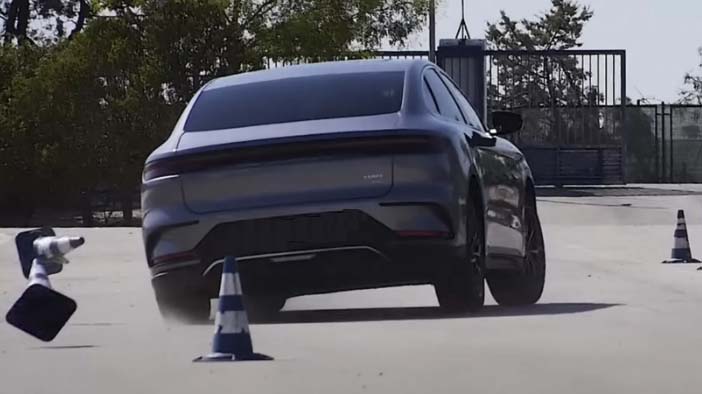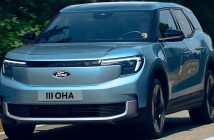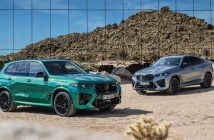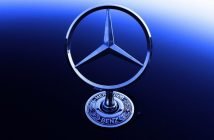+++ Some will remember the first teaser images for the Maserati MC20 published in early 2020 depicted a heavily modified ALFA ROMEO 4C test mule. There’s a perfectly good reason for that since Modena’s supercar was initially supposed to wear the Alfa Romeo badge. In an interview, Alfa’s head of product Daniel Guzzafame said the MC20 actually started out in life as an Alfa before a switch to the trident badge was decided. Despite transitioning to another marque within FCA (now Stellantis) while the car was in the works, the door was left open for Alfa Romeo to be a part of the project again. The new 33 Stradale has a strong connection with the MC20 but it’s more than just a reskinned version of Maserati’s flagship model. Aside from having a different body, both the front and rear suspension are tailor-made while the front H-frame and the rear aluminium frame are unique as well. In addition, the engines are also different since the 33 Stradale uses the Giulia and Stelvio Quadrifoglio’s 2.9-litre V6 bored out to 3.0 litres while the MC20 has Maserati’s own Nettuno, also a 3.0-litre V6 with a pair of turbochargers. The 2 supercars use different gearboxes as well, an 8-speed, dual-clutch from ZF in the case of the Alfa while the MC20 has a Tremec-developed 8-speed dual-clutch. While the MC20 has spawned a convertible version dubbed Cielo and a couple of track-only derivatives, that won’t be the case with the 33 Stradale. Daniel Guzzafame says Alfa will stick to its original plan and make only 33 coupes. About 2 to 3 cars are going to be assembled monthly and customers still have approximately 12 months left to choose whether they want the ICE or the purely electric powertrain. Alfa Romeo hasn’t decided how many electric motors the zero-emission 33 Stradale is going to have, but he didn’t rule out an AWD variant with 2 e-motors at the back and another one at the front. The electric variant will be related to some extent to the MC20 Folgore. All 33 cars planned for production were sold about a year ago and there won’t be any extensions. +++
+++ The all-new and all-electric AUDI A7 AVANT E-TRON has been spied undergoing its final stages of testing before its full reveal next year. Audi’s ambition to produce a large electric estate is no secret, the firm debuting a concept version a couple of years ago (details below), but that plan will soon yield results in the shape of this production model. The new A7 Avant e-Tron will do battle with the forthcoming BMW i5 Touring, and later an all-electric Volvo estate, in this entirely new class of car. The A7 Avant e-Tron will join a 5-door Sportback version, but this doesn’t spell the end for Audi’s existing ICE-powered A7 models. Alongside the standard A7 Avant e-Tron will be a higher powered S7 Avant e-Tron with a bespoke-bodied, range-topping RS7 e-Tron to follow in the next few years. The new A7 e-Tron models sit on the same Premium Platform Electric (PPE) underpinnings as the forthcoming Q6 e-Tron, which has been co-developed with Porsche and will share much with the new Porsche Macan EV. The platform utilises an 800 Volt electronic architecture that enables rapid charging at up to 270 kW, meaning a 5 to 80 percent charge takes less than 25 minutes, while plugging in for 10 minutes can provide an extra 300 km of range. Based on the information already revealed about the closely related Q6 e-Tron, the A7 e-Tron will be powered by twin-motor powertrains drawing power from a 100 kWh battery pack. The 100 kWh unit will stand as the largest battery offered, but lower-specification models with a single motor option are also on the cards. Fitted with the most efficient combination of powertrain elements, we could expect up to 640 km should be possible on a charge, judging by the Q6 e-Tron’s claimed 600 km range. For the Q6 e-Tron, Audi will launch both a base model and high performance SQ6 model with 400 hp and 520 hp, respectively. These are figures that we expect to be mirrored by the A7 Avant e-Tron and its S7 version. +++
+++ BMW development boss Frank Weber has confirmed that the firm’s next M3-sized performance saloon (and potentially a Touring estate) will go all-electric. The M3 EV will be based on the firm’s Neue Klasse platform, with an on-sale date as early as 2027, “not too far away from the initial launch of the Neue Klasse as a product line”, according to Weber. Speaking at the launch of the brand’s new 5 Series and i5 electric saloon, and musing on whether BMW needs a halo model once a production saloon car based on the Neue Klasse platform goes on sale from 2025, Weber confirmed: “The next M3 will be fully battery electric and will have ‘the heart of joy’ (referring to a new ECU package). This ECU control unit was designed for four independently operating electric motors up to 1 megawatt (1.360 hp) and therefore yes, it needs a lighthouse project”, says Weber. BMW’s new ECU combines controllers for the stability control, powertrain/battery and chassis software into one hardware unit as part of the biggest investment in BMW’s history in terms of the Neue Klasse platform, and will unlock new dynamic capabilities according to M division boss Frank van Meel. “We call it ‘hand of god’, like we had on the M5 with the M xDrive system”, he said when referring to the new ECU tech. “In the future, when you talk about four electric motors for instance, you need the hand of god to be even stronger. Then you don’t just need the lateral and longitudinal dynamics from a chassis point of view as with the M xDrive system, but also the engine. It has to be one centralized logic because on track you want to decelerate at up to 1G or more, but at the same time you want to recuperate and have the right stability”, van Meel added. It doesn’t matter if I do ABS braking or brake with the motors, because the motors are faster than the hydraulics anyway, but it is a prerequisite for going into a new era with M and electric high-performance vehicles. It means you can drive this car in a way you never have before”. While van Meel outlined that the platform has up to one megawatt of installed power at its disposal, it’s unlikely the next M3 model will feature this level of power. In fact, the M boss believes that it’s not all about power and that vehicle dynamics will define how electric M cars drive in the future, differentiating BMW’s products from its rivals. “We don’t need a megawatt of power, but of course we are installing this because we don’t only think about the M3”, he told. “We will go up to maybe XM or X5 M, and if those cars have some weight we need that power for the typical M driving feel. But it is all about vehicle dynamics, the overall vehicle concept”. Driver interaction will be key to future M division EVs as well, van Meel believes. Asked if the firm would look to simulate gear changes to boost involvement, the exec said: “If you have just one gear and you have no feedback at all, you don’t know how fast you are and you cannot look down at the speed. It’s a little bit like a motorcycle, third gear and you hear the revs. So actually you do know if you’re doing one hundred and thirty, a hundred thirty five, and then you have the shifting lights that you can see from the corner of your eye. So you don’t need to look down. You always know how fast you are, and that’s missing if you have no acoustic feedback, also no haptic feedback. We are looking into different ways of giving you that feedback”. As for the petrol-powered M3, it’s likely that this car will be sold alongside the new M car based on BMW’s Neue Klasse platform. Weber outlined that BMW has developed the current 3.0-litre turbocharged straight-6 engine to comply with Euro 7 emissions regulations, giving the motor a stay of execution well into the future, meaning the combustion-engined M3’s lifespan will likely overlap with the all-electric model coming from 2027. +++
+++ China is slowly but surely cracking Europe. Whether it be the fact that there were twice as many Chinese automakers at the 2023 Munich Motor Show than last time or that the country is building more ships to accommodate growing demand, the EU’s automotive landscape is rapidly changing. At the head of the charge is BYD , which is the self-proclaimed world leader in “new energy vehicles” (aka, EVs and hybrids) and has progressively made inroads into the West. Back in its homeland of China, the company is a force to be reckoned with in the electric space. In Europe, it faces competition from not only the likes of better-known favorites such as Hyundai, Kia and Skoda, but also from premium brands. Going toe-to-toe with the Mercedes-Benz EQE and the BMW i5, the BYD Han is a hugely important car for the brand. And on paper, it does well. Not only does it undercut its competition on price, but the Han also offers all-wheel drive and an electric range of 521 km on the WLTP cycle. Perhaps the most impressive part, though, is its speed. The BYD Han can rocket to 100 km/h in just 3.9 seconds. To put that into perspective, the BMW i5 eDrive40 will take 6 seconds to do the same, while the Mercedes-Benz EQE 300 takes a comparatively yawn-inducing 7.3 seconds. But, to paraphrase a certain superhero, with great power comes the need for great control. And that may just be where the Han proposition starts to unravel. At least, that’s what the findings from a test suggest, as the car is put through the channel’s internet-famous range of agility probes. In the slalom, it would appear that the tester has difficulty with the responsiveness of the BYD’s throttle. The car is too eager to pile on the speed, meaning that keeping a consistent pace is challenging. The tester calls the car wild and even likens it to a Scalextric car, such is the twitchiness of the throttle. The Han eventually manages to weave through the cones in the same time as the BMW X1 xDrive3, at 23.9 seconds. While not an atrocious result, it trails the leading time set by a Porsche Taycan GTS of 21.5 seconds. Next up is the infamous moose test; a trial that has proven to upset even the best sports cars, throwing some surprise results. Sadly for the BYD, the Han fails to perform at the benchmark entry speed of 77 km/h. Suffering from bags of understeer, it takes out several cones and fails to even make it across to the third set. The EV performs much better at a lower speed of 70 km/h. However, the Han may have done even better; it could just have scraped through with its performance at 74 km/h, but the eagle-eyed observers noticed that the car brushed a cone on entry to the second section. The moose test result may come as a bit of a disappointment to anyone considering the BYD Han. To put it into perspective, while the Mercedes EQE 350 sedan didn’t manage to pass at the 77 km/h benchmark either, however it did successfully the course with a respectable pace of 74 km/h. It was also faster (and crucially: more predictable) through the slalom. The testers conclude that the BYD Han is not worthy of the “sports sedan” mantle. Instead, it impresses with its power and luxury. But when it comes to chassis dynamics, it would seem the company may need to make a few tweaks. +++

+++ For a long time, range anxiety has been cited as the main reason car buyers aren’t willing to make the switch to all-electric vehicles. However, automakers and battery manufacturers have made significant advances in recent years to the point that current EVs provide decent range for the typical user. That said, there are still significant hurdles the EV industry needs to overcome, and charging may be the most significant, according to FORD boss Jim Farley. The executive voiced his opinion that consumers are not committing to EVs because they have “charging anxiety”. “We’re going into the mass consumers who have a lot of charging anxiety. They don’t have range anxiety, they have charging anxiety”, Farley said. His comments came in response to US Secretary of Energy Jennifer Granholm’s recent 4-day, 1.000 km EV road trip from Charlotte, North Carolina, to Memphis, Tennessee, that saw some staff members block a charger with a petrol-powered car to “reserve” it for Granholm’s car. It’s pretty obvious that the US charging infrastructure leaves a lot to be desired both in terms of coverage and reliability, but there’s a notable exception: Tesla’s Supercharger network. Ford acknowledged that earlier this year when it signed an agreement to adopt the EV maker’s NACS charging port on its electric cars starting in 2025. Charging challenges aside, Ford’s head honcho said EVs are also at a disadvantage in the market today because of their higher prices compared to ICE alternatives. He suggested that consumers are “not willing to pay a premium” for EVs, despite the fact an increasing number of models are becoming available and prices have dropped from a year ago. “Some customers who have the right duty cycle are really interested, but the price premium that we see a year ago is not there today”, Farley explained. Ford has yet to offer an affordable EV in the US and Europe, with its lowest-priced model being the Mustang Mach-E, which isn’t exactly cheap. Ford did announce plans to launch the Puma EV in 2024 in Europe, but there’s no indication that it will make it stateside. General Motors covers the affordable end of the EV market better thanks to its Bolt EV and EUV that start under €27.500, but these models will be discontinued at the end of the year. Still, GM has pledged that the upcoming Equinox EV will start around the same figure. +++
+++ Government agencies around the world continue to scrutinize automakers in the wake of the 2015 Dieselgate scandal. According to a leaked letter from the German Federal Motor Transport Authority, MERCEDES-BENZ was in the agency’s crosshairs earlier this summer, accused of using defeat devices to bypass the latest Euro 6 emissions standards. The memo (in German), dated 7 July 2023, detailed 3 software-based defeat devices found on the OM642 diesel engine used in the Mercedes-Benz E350 BlueTec. 2 of the devices altered engine operation based on certain temperature parameters. The agency told the automaker in the letter that it had to fix the issues, or the cars would be banned from operating and recalled. The German environmental consumer protection group Deutsche Umwelthilfe (DUH) published the leaked letter on Friday, which it received from an unnamed whistleblower. Mercedes, which is cooperating with the agency, told it believes that it has already developed and deployed the proper software updates needed to address the issues. The additional scrutiny arrived after the European Court of Justice ruled in July 2022 that software-based defeat devices were illegal. The agency had given the company until 27 July to comply, but that it had received an extension. This isn’t the first time Deutsche Umwelthilfe has scrutinized Mercedes. In November 2021, the organization issued a public report that accused the company of using eight defeat devices in its E-Class vehicles equipped with its Euro 6-compliant diesel engine: the OM642 power plant. DUH deemed the devices illegal. According to the report, the devices reduced the amount of AdBlue injected that is needed to neutralize harmful nitrogen oxides. Mercedes isn’t the only automaker still facing the consequences of the Dieselgate scandal 8 years after it broke. This summer, a court fined former Audi CEO Rupert Stadler 1.1-million euros for his involvement in the scandal. He confessed to avoid receiving a prison sentence. In 2020, Mercedes’s parent, Daimler, had to pay €2.6 billion to settle claims against the company in the United States. The automaker faced cases from the US Environmental Protection Agency, the California Air Resources Board, the US Department of Justice, and a class-action lawsuit. +++
+++ POLESTAR is what Gregor Hembrough, head of Polestar USA, calls “a 97-year-old start-up”, In that position, the automaker has a little more flexibility and wisdom when it comes to how it’ll position itself in the market. In a new interview with CEO Thomas Ingenlath, the choice is clear: carve out a path that’s nothing like what Tesla has done. Ingenlath has a big job ahead of him. Taking market share away in today’s wildly competitive automotive market isn’t easy. Taking it away from huge players in the EV space like Tesla could prove harder. Polestar’s plan is to be decidedly different, something we got a taste of last month at its launch of the updated ‘2’. In a recent interview, Ingenlath laid out exactly why Polestar isn’t chasing Tesla, how it differentiates itself to the customer, and what the future holds. Specifically, he’s sticking to his guns when it comes to a pricing war with other automakers including Tesla: “We have very clearly stated we will not get into a price war to achieve volume targets because we want to maintain our premium position. We are definitely not running after Tesla, which wants to have X factories and volumes in the millions”. Instead, Ingenlath believes that it’s important for Polestar to be a company rooted in high quality rather than a low price. “We want the Polestar 3, 4 and 5 to firmly secure our place in the premium luxury segment rather than producing smaller, cheaper cars”, he said. To make the point even further he highlighted how Polestar just updated the 2: “We made it better and a bit more expensive. We could have done the exact the opposite, taking value out by giving it a cheaper battery, a cheaper electric drivetrain and use cheaper materials and kept the same price. Or we could have followed Tesla and only offer one screen and save big bucks because that monitor in front of the driver is expensive. But we didn’t”. That attitude is one that he hopes will demonstrate a love of design and technology and the passion that Polestar has for the product. He believes it’ll translate to the customer and ultimately bring more sales. Only time will tell if this plan will prove successful, but what is no doubt coming down the pipeline is something he dubbed “Polestar Day” later this year. At that event, the company will talk about recent innovations, the partners it’s working with, and what the future holds. We know that it’ll include more cars here in the USA and abroad but we’ll have to wait until the event happens later this year to get all of the details. +++
+++ The percentage of new vehicles sold in the UNITED STATES that are electric vehicles (EVs) has risen in the first 7 months of to 7.2%. This marks a significant increase from the 4.9% they represented in the same January-July period last year. Data from Experian has revealed that this year, new EV registrations in the U.S. hit 655.986 units while total new light-vehicle registrations rose to roughly 9.1 million. As expected, it is Tesla that continues to lead the way, accounting for a staggering 59.5% of all new EVs sold in the United States with a total of 390.377 registrations. The Model Y proved particularly popular in the 7-month period to July with some 236.041 registrations being recorded, more than double the same time last year. Demand for the Model 3 also jumped with 21% more registrations, totaling 131.381 units. Registrations for the Model S and Model X fell by 51% and 14% to 8.943 and 14.462 units respectively. Sitting in second position was General Motors with 39.647 new EV registrations or 6% of the total market. This positioned it slightly ahead of Ford with 33.955 registrations or 5.2%. Hyundai then followed with 28.198 registrations (4.3%), BMW had 23.116 registrations (3.5%) and Mercedes-Benz recorded 21.160 new EV registrations (3.2%). J.D. Power vice president and electric vehicle practice Elizabeth Krear, indicated that the share of EVs rose to 8.5% in July and Tesla’s share jumped to 63%. “Affordability remains the highest-scoring factor at 97, driven by aggressive pricing from Tesla”, Krear said. “Although the affordability factor is approaching parity, it is skewed by the premium market, driven largely by Tesla’s 63 percent EV market share”. +++
+++ The race to build the world’s most aerodynamic electric production model appears to be heating up. So far, the Mercedes-Benz EQS is ahead of the pack with a drag coefficient of 0.20, but BYD aims to surpass the German saloon with its new luxury EV. At the Academic Annual Conference Of Automotive Aerodynamics Committee of China, BYD confirmed the YANGWANG U6 will have a drag coefficient of just 0.195, better than the EQS, Nio ET7 (0.208 Cd), Tesla Model S Plaid (0.208 Cd), Lucid Air (0.21 Cd) and even the Porsche Taycan (0.22 Cd). The drag coefficient is a measure of how aerodynamically streamlined a vehicle is. A lower drag coefficient indicates less drag or resistance, which means the car can cut through the air by consuming relatively less energy. Conversely, a higher drag coefficient implies greater resistance and reduced efficiency in motion, which could impact the driving range among EVs. The world’s largest EV maker launched its upscale Yangwang arm early this year and unveiled a couple of upmarket models called the U8, a rugged off-roader that can do tank turns, and the U9 supercar, which in BYD’s film was seen jumping off the ground, thanks to a sophisticated suspension system called Disus. The U6 appears to be the next big launch under BYD’s Yangwang moniker. EU patent images revealed a high-end saloon in the league of the BMW i7. A teaser from the conference revealed flush door handles, a low belt line, smooth bodywork, aero wheel covers, and digital mirrors. The EV has an active rear spoiler. The Model S Plaid rivalling saloon could borrow the quad-motor powertrain from the U8, rated at 1.200 hp. The estimated price of the U6 is 105.000 euro. +++



